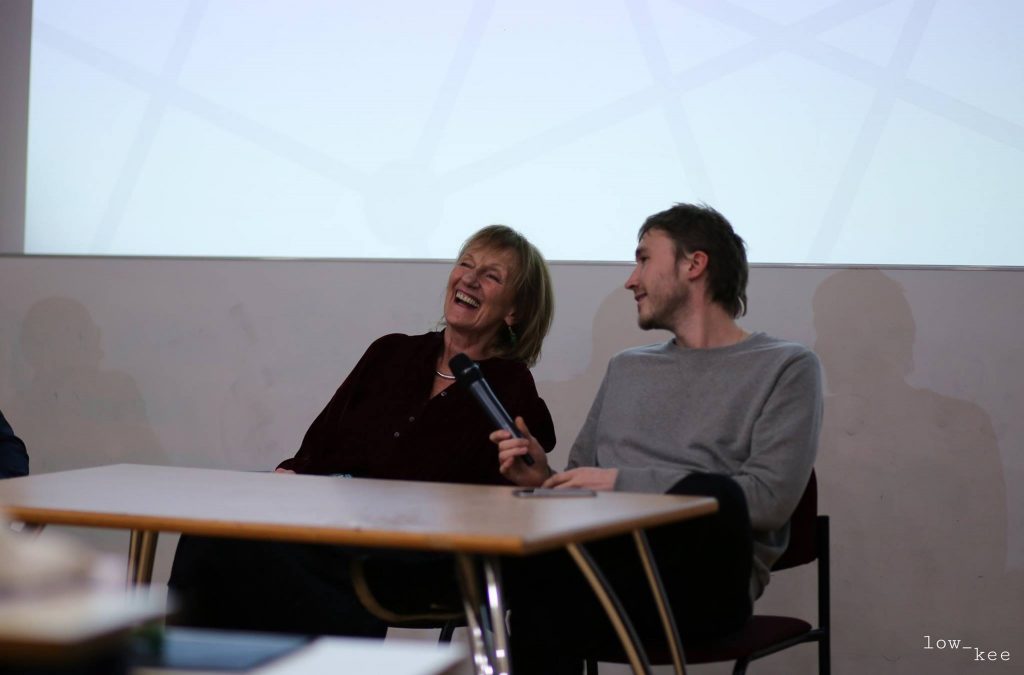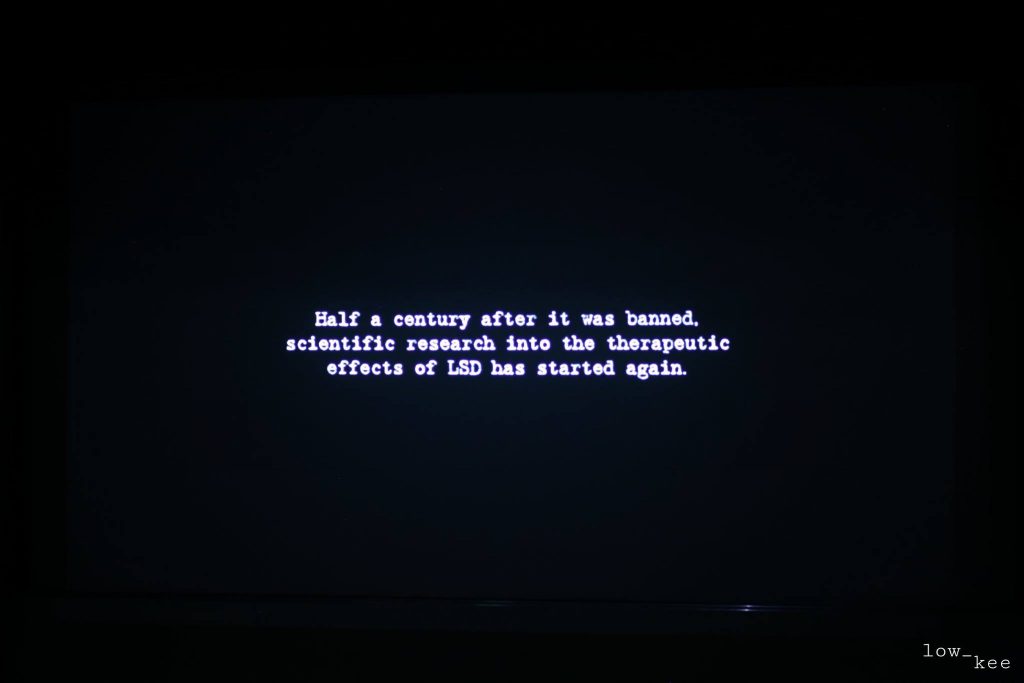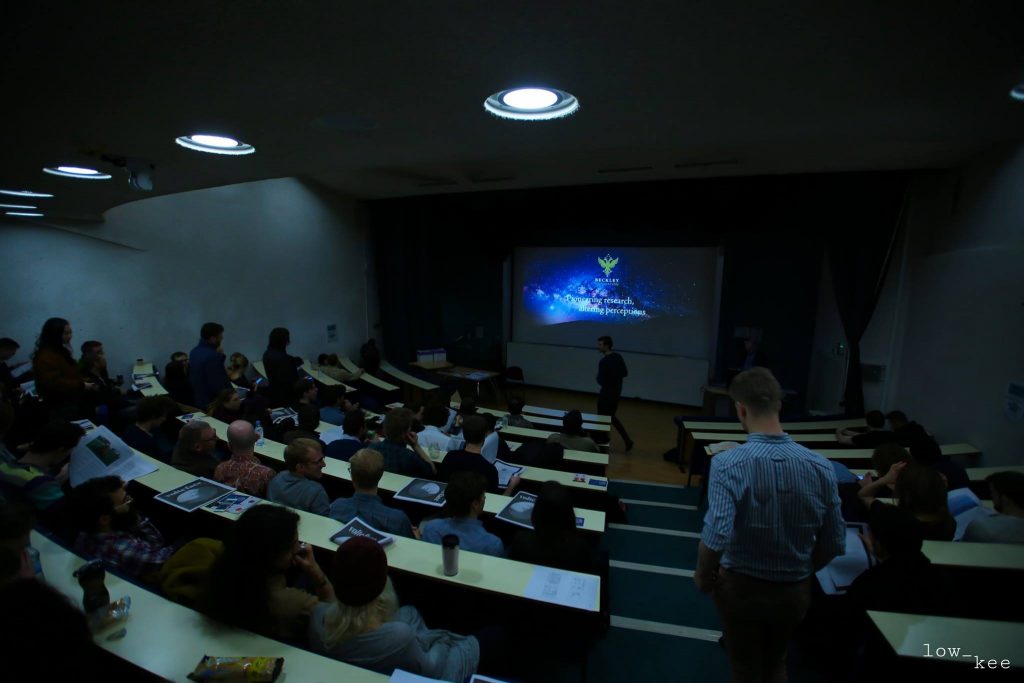“I first met Nick [Sands] when I was about 15. I was revising for my GCSE Chemistry and he visited; he’d recently got out of prison. He was an old friend of mum’s. I actually remember him trying to teach me Chemistry, mostly… Luckily, I didn’t listen! Nick’s a real teenager, young at heart.”
We’re at a ‘Q and A’ following an exclusive screening of Cosmo Feilding-Mellen’s new documentary, The Sunshine Makers (2017), jointly hosted by Volteface, The Beckley Foundation, UCL Society for the Application of Psychedelics, KCL Society for Psychedelic Studies and the Maudsley Psychedelic Society.
A hazy, heady mix of present-day interviews, archival footage, mellifluously sugary animations and bubbling music (an original score by The Heliocentrics), this documentary lulls us into the beginnings of a trip, which unfolds to chart the partnership and pharmacological productivity, imprisonment and present-day perspectives of Nick Sands and Tim Scully, whose celebrated ‘Orange Sunshine’ LSD lit up hearts and minds across the United States, often thousands of microdots at a time, and fuelled the counter-culture of the 1960s.
Does Cosmo’s inner teenager feel a smidgen of regret at having squandered a once-in-a-lifetime opportunity to segue from the sterility of his government-approved chemistry syllabus into a masterclass on illicit LSD production by Nick Sands, a doyen of psychotropic manufacture? His mother Amanda Feilding, a denizen from the intellectual demesne of 60s psychedelia-turned Beckley Foundation director, would almost certainly have been disappointed at the time… But if so, Cosmo has certainly made up for it with the cinematography and spirit of his latest creation. He may not have absorbed Sands’ pointers on the particulars of producing LSD, but in directing The Sunshine Makers he has achieved an authentic, undulating and unrelenting homage to acid.
Fittingly, when Cosmo and Amanda take to the stage as the credits roll, our collective transition into a ‘Q and A’ feels almost seamless. Cosmo’s film pertains with utter faithfulness to his family’s unique universe: an intellectual playground where anything is possible and where a voracious passion for the science behind the magic and a cerebral revelry in the cultural and neural changes which LSD has the potential to effect are intricately twinned and infinitely explorable. Amanda and Cosmo have another famous LSD manufacturer friend, (William) Leonard Pickard, who is currently serving time in a maximum-security prison. “I was speaking to him about the film on the phone last week,” says Cosmo; for all the gorgeous cadences of The Sunshine Makers’ aesthetic, this is a glimpse into a bona fide reality, and we’re privileged to engage with it at such close proximity.
“I first met Nick in California when he’d just got out of prison,” says Amanda. “We were at a conference. I was talking about my favourite subject: LSD, and consciousness, and the underlying mechanisms behind it. [Research] which has ended up in many things including the Beckley/Imperial Research Programme– we’re finally finding out some of the things we were getting ideas about in 1966.”
Amanda’s tireless campaigning for the resumption of high-level clinical research into LSD bore tremendous fruit last year; in April 2016, the Beckley/Imperial Research Programme which she co-directs with Prof David Nutt released the results of the world’s first brain imaging study on LSD, lead by Robin Carhart-Harris. But what about Nick and Tim’s specific brand – back in the day, did Amanda drop their ‘Orange Sunshine,’ and if so, how was it? We’re met with a glib glimmer of a smile and a thousand-year-old stare: “Not consciously.”
Cosmo has mastered the art of such beautiful cinematic storytelling that The Sunshine Makers unfolds like a blotter-sheet. As his interviewees rev their engines and begin to scope out the curves of their very special memory lanes, everyone involved in the making and distribution of the ‘Orange Sunshine’ LSD, and indeed the sequence of shrewd, beautiful women involved with the Sunshine Makers themselves, faces the camera with a faux-matter-of-fact tone, behind which they thrill in the paradoxical outlandish ingenuity of the true stories they’re disclosing. Every plot progression – getaway cars, disguises, new labs – is delineated with breezy simplicity. Of the pair’s irrepressible ability to decant their production lab to different states, Nick explains: “LSD became illegal in California first. What you need to remember about the United States is that it’s fifty states and they aren’t all that united. That’s why the Denver lab was not in California…”
As Nick and Tim become the focus of increasingly officious attention from the federal police, they shimmy across the U.S., reassembling their equipment and resuming LSD production. Both their geographical trajectory, and the evolution of their relationships with individuals and organisations are illustrated by infinitesimally appearing pieces of paper which creep – trippily autonomously – onto drawing boards – they’ve used an animation technique called “rotoscoping,” Cosmo explains, to give these sequences, and the archival footage of car-chases, an apt, slightly cartoonish, fantasy gloss. Although, technically, the rays of ‘Orange Sunshine’ took the form of microdots, the aesthetic technique of sweeping the narrative along with the aid of an unremittingly generous paper trail feels suitable to a film made by the son of a fervent aficionado of LSD, about its most celebrated manufacturers.
Wry, witty and brimming with vivacious affection as she dips back into the past, Nick’s long-time lover Jill Henry, (still nurturing minds, but now as a Montessori teacher) is a particularly adept contributor to Cosmo’s intended rendering of Nick and Tim as much-loved humans, rather than figures iconised by the scale and success of their LSD distribution operation: “Nick likes to make love so much y’know? I mean [sex] is important to me but he’s almost…utilitarian!”
We’re privileged to be party to some bonus sexcapades that didn’t make the final edit: “Tim Scully was a genius, he built a particle accelerator at school at 14,” Cosmo recounts. “When the Grateful Dead were driving through America, playing to crowds on ‘Orange Sunshine,’ they brought him along for the ride. Imagine, there was Tim, this incredibly nerdy guy […] and they encountered Hell’s Angels, all sorts, and they partied a lot. In a social sense, he was very out of his depth: some girl jumped into bed with him, but then she slept with whole band. She left everyone with an STD and they made him pay all of their medical bills!” A treasured memory all round, no doubt.
Cosmo is also fascinatingly revealing about Nick and Tim’s varying experiences of the aftermath. Entirely faithful to one another in their court testimonies, they both incurred prison sentences. Cosmo describes with amused affection that Tim’s sentence was reduced because, he “made a point of behaving himself, he used to tend the roses. He made it his thing to take roses to the prison governor.” A free man and a careful chronicler of the history of illicit LSD production who has collected “literally every piece of information about LSD,” his participation in the documentary is the result of months of careful persuading by Cosmo.
“He had a horrible experience soon after he got out of prison,” Cosmo explains, “he was taken to court by a guy whose son had tried LSD and freaked out and killed himself.” Understandably, his current persona is a far cry from the starry-eyed first-time tripper who says to himself at the start of the documentary, “your job on this planet is to make psychedelics and turn on the world […] We could turn on everyone and maybe it would save the world.”
Whilst Tim was forging a reputation as the “rose man of prison,” Nick was -beautifully incorrigibly- hosting psychedelic sessions in his cell. He relates with obvious pride how his girlfriend would arrive for prison visits with a balloon full of psychedelics in her mouth, which she would transfer into his as they kissed. After the drugs had passed through his system, he’d hand them out among his cellmates. “We made a psychedelic cell! Even this mafia guy- he took the acid with us, to prove he wasn’t a pussy. And, as he came out of the cell he said, you know guys- that’s the first time I’ve been to church in thirty years!” And did the Sunshine Makers’ different experiences of their time apart, pull them apart? In some ways, it did. “When Nick and Tim hug on film,” Amanda points out, “that moment really is special as it’s the first time they’ve seen each other in ten to twelve years!”
‘Orange Sunshine’ may have long-since passed into history, but what’s on the horizon for LSD? Psychiatrist Dr James Rucker, head of the Maudsley Psychedelic Society, suggests, “I don’t think there’s a need for a revolution- I just think it’s about opening up the dialogue we have about drugs. Society’s almost like a pendulum,” he explains, “in the ‘60s, we had a great time, then the party fell apart, as parties do, and that’s given way to a more measured discussion now.”
And what would we have to change for LSD to become legal again? “The Daily Mail would have to change,” says Amanda, with maudlin stoicism. “The editor would have to… pass on…” Whilst we’re waiting, it’s comforting in some ways to reflect, as Cosmo observes, that Silicone Valley is now the global epicentre of business “and it was basically founded on LSD and they’re all microdosing now like it’s coffee.” He touches on a recent conversation with documentary interviewee and former leader of the Brotherhood of Eternal Love [the former stick-up men who “turned on” to LSD and became the official distributors of Orange Sunshine’] Mike Randall, who looks with pride on LSD’s journey through the decades at Silicon Valley: “LSD is much doing better fifty years on than Christianity was doing fifty years after the death of Jesus Christ!” Furthermore, the LSD market has naturally regulated itself in terms of the doses people are taking. The average recreational dose has dropped from 300 micrograms to 100, whilst the increasingly popular microdose weighs in at around 10-15.
The second wave of psychedelic research is being carried out, largely, by neuroscientists, psychiatrists and pharmacologists who present at conferences in suits and ties. It is going about its academic business, and for the most-part is keeping a wary distance from the aesthetics, culture and devil-may-care irregularity that characterised the research that took place during the Orange Sunshine-era Psychedelic Revolution. Precise adherence to protocols may lack the seductive rebelliousness that makes The Sunshine Makers such an exhilarating trip, but as the Q and A with Amanda and Cosmo draws to a close, the afterglow is positive. Today’s sharpest scientific minds are already proving the many beneficial medical applications of various currently banned psychoactive substances, and they may yet “turn the world on” to psychedelics.
Rosalind Stone is Director of Development for Drugs and Me. She has also written for Psymposia, Talking Drugs, The Stylist and The Londonist. Tweets @RosalindSt0ne



